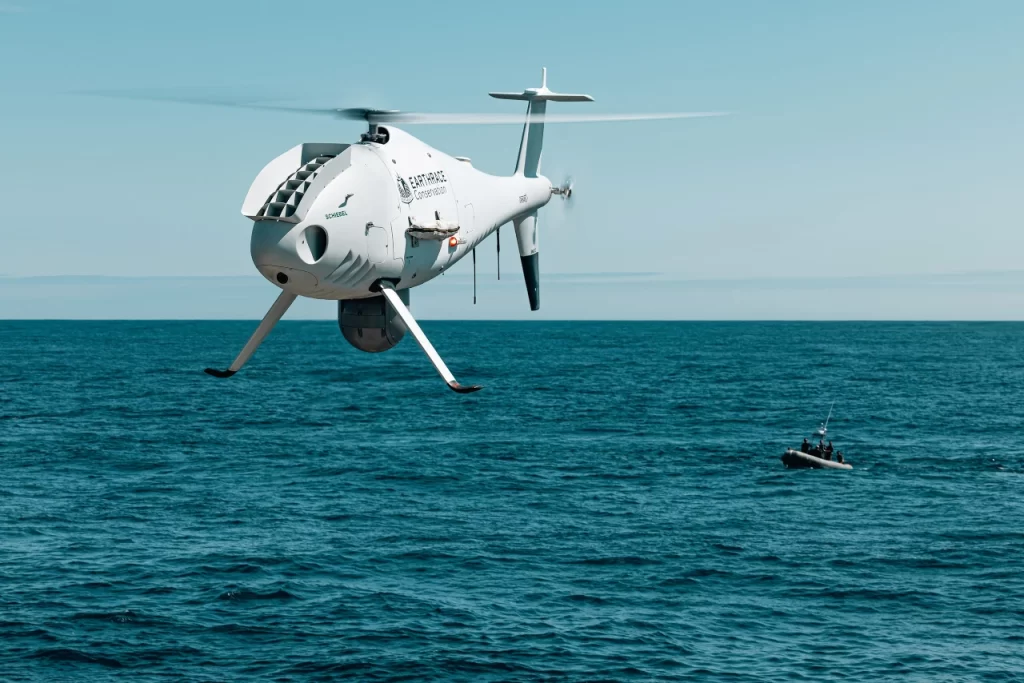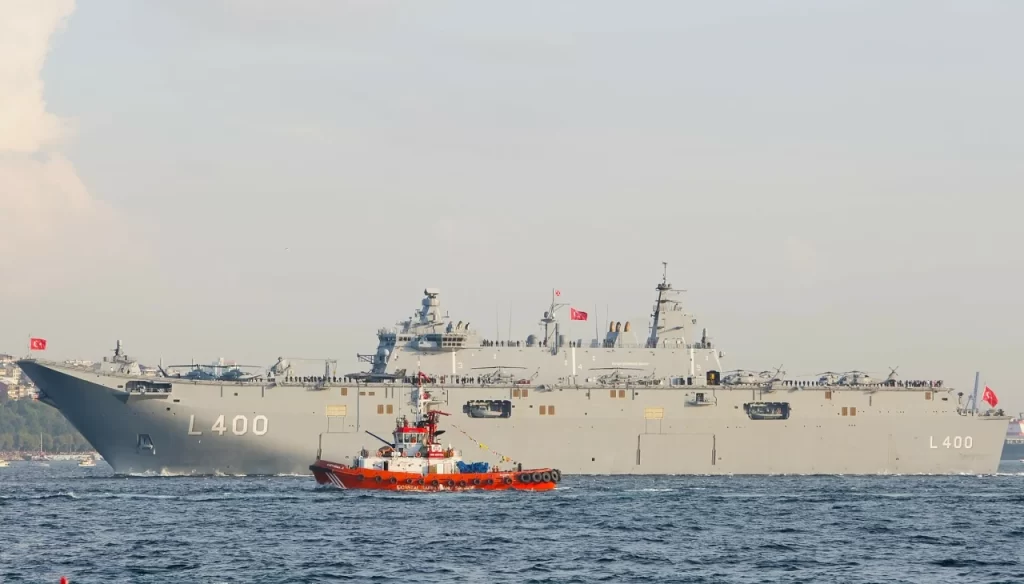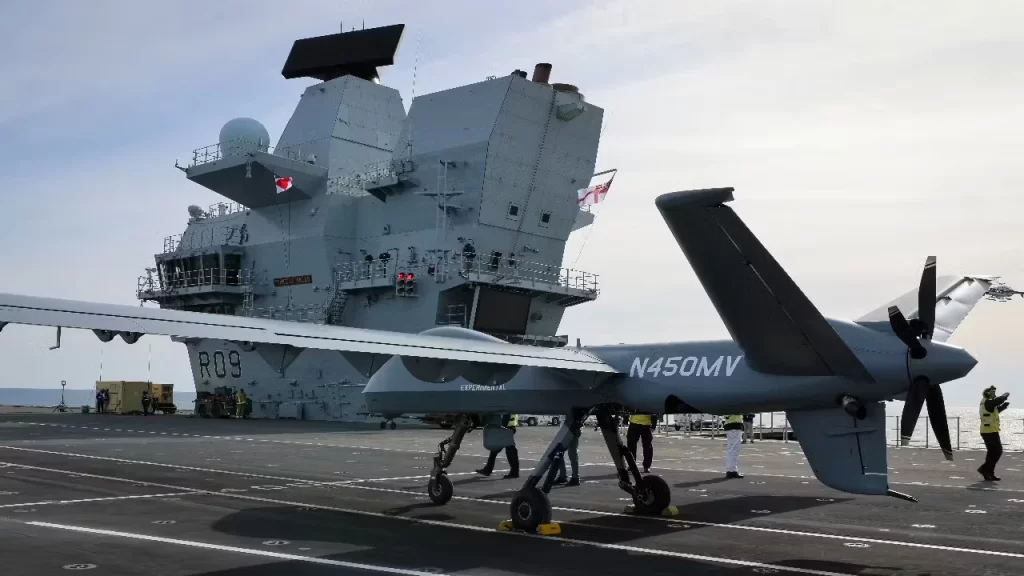Drones and other unmanned Aerial Systems (UAV) are poised to play an increasingly important role in future conflicts. Because of their adaptability, versatility, and reduced cost, carrier-based drones attract much interest from naval forces worldwide.
UAVs are now being carried on aircraft carriers, destroyers, frigates, and amphibious vessels and use onboard weapon modules, communication modules, sensor modules, and so on to perform tasks such as aerial reconnaissance, communication relay, firepower strikes, electronic warfare, thereby increasing operational efficiency.
The most recent example is the Indian aircraft carrier INS Vikrant, which successfully landed and took off to test a UAV manufactured in India. The UK’s aircraft carrier “Prince of Wales” recently launched and retrieved the US General Atomics Aeronautical Systems, Inc.-supplied “MQ-9 Reaper,” a large-scale reconnaissance and strike-integrated drone, as part of its carrier-based drone testing programme. The TCG Anadolu, Turkey’s first drone carrier, and its TB-3 surveillance and strike-integrated drone are expected to conduct similar tests.
The United States was the first to create drones that could be launched from a carrier. During the Vietnam War, the US Navy launched the jet-powered Ryan Model 147 Lightning Bug drone from the aircraft carrier “Intrepid” on numerous occasions to undertake close surveillance operations. The missions assigned to US carrier-based drones expanded from battlefield reconnaissance, naval gunfire target designation, and ballistic missile calibration to minesweeping, anti-submarine warfare, beyond-line-of-sight target designation, aerial refuelling for fighter aircraft, and other missions. To hasten the development of drone integration on carriers, the US Navy built a dedicated carrier-based drone acquisition system and launched projects such as the X-47B.

The US has pursued the “Third Offset Strategy” in recent years, improving the conceptual design of unmanned warfare and organising several exercises, including unmanned combat and manned/unmanned cooperation operations. According to reports, drones will account for 60% of future US Navy aircraft, with the MQ-25 “Stingray” multi-role drone officially joining US carrier air wings around 2030.
Other countries are actively adopting this approach as well. Russia’s 23900 helicopter carrier, currently under construction, is intended to carry four carrier-based drones, with a first flight scheduled for 2025 and mass production beginning in 2026. The French Navy developed its first carrier-based drone squadron in 2019, armed with the S-100 drone and deployed on the amphibious assault ship “Mistral.”
UAVs can now perform several naval duties previously limited to fixed and rotary-wing manned aircraft.
Surveillance and Reconnaissance
UAVs can carry payloads such as optical, radar, and magnetic sensors with great manoeuvrability, endurance, and range. They may operate in numerous directions and batches, conducting long-range reconnaissance in collaboration to minimise the blind spots beyond the visual range of naval radars. This capability expands the fleet’s early warning and reconnaissance coverage by providing all-encompassing, long-range air, surface, and anti-submarine surveillance. For example, the US Navy’s “ScanEagle” and RQ-21A “Blackjack” carrier-based drones may perform substantial optical reconnaissance operations.
Improved Communication Relay Capability
UAVs outfitted with onboard communication self-networking devices may quickly form communication networks, taking advantage of their vast communication range and massive deployment numbers. They may build communication networks incorporating surface vessels, manned aircraft, and unmanned aerial vehicles (UAVs), offering long-range communication relay services for low-altitude helicopters, beyond-visual-range reconnaissance UAVs, and beyond-visual-range surface vessels. This is an excellent adjunct to existing platforms for information exchange, situational awareness, and command and control. Several countries, notably the United States, Canada, and Sweden have used the CL-227, CL-327, and CL-427 multi-purpose dual-rotor UAVs as C3I relay stations.
Diversification of Cooperative Combat Styles

Carrier-based UAVs can coordinate actions with the mother ship using independent or swarm tactics, effectively compensating for various naval-formation weaknesses and significantly improving surface vessels’ offensive and defensive capabilities. UAV swarms with small magnetic sensors may monitor broad underwater battlefields, continuously identifying and tracking underwater targets, boosting the fleet’s anti-submarine detection and three-dimensional anti-submarine capabilities. UAV swarms can make ultra-low-altitude breakthroughs in enemy ship formation during anti-ship attacks, resulting in super-saturation attacks. This depletes a percentage of the enemy’s air defence firepower and selectively damages enemy radar and other warning-detecting equipment. Electronic deception, missile strikes, and sensor-triggered self-destruction of UAVs can be employed in air defence operations to interfere with electronic and incoming targets, relieving the operating load on air defence missile systems. UAV swarms can monitor surrounding water areas, coastline areas of landing zones, and so on in amphibious operations, delivering operational information on adversary landing barriers and weaponry configurations. They may disable enemy warning detecting equipment, assault and clear landing obstructions and artillery systems, allowing future soldiers to land smoothly.
Improved Support and Logistics Capability
UAVs can provide support and logistics for manned fighter aircraft on missions, greatly increasing the range of manned carrier-based aircraft and effectively compensating for flaws such as their short loitering period. According to publicly available US military statistics, the operational radius of the F/A-18E/F “Super Hornet” carrier-based fighter can be expanded from over 700 kilometres to over 1,300 kilometres during collaborative operations with the refueling-capable “Stingray” UAV.
Modern Naval Warfare Characteristics and the Immediate Need for Carrier-Based Drones
Capabilities beyond visual range, wide coverage, multi-domain integration, and high intelligence distinguish modern naval warfare. These qualities have resulted in a high demand for drones on naval vessels. The development trends of carrier-based drones are favourable but also bring new hurdles for rising technology research and implementation. Platform autonomy, payload modularisation, and control standardisation are all becoming more visible.

Higher Intelligence Requirements
The need for mixed operations of unmanned and human aircraft is obvious in the confined space of an aircraft carrier. Unmanned drone activities on the deck, including reactions to command signals during deck scheduling, should ideally be indistinguishable from those of manned aircraft. During long-range missions, remote control is unstable, and staff on aircraft carriers is insufficient to manage many drones manually. For carrier-based drones, this needs a high level of autonomy. Countries are developing drones that use artificial intelligence, enabling deep learning, anticipating emergencies, and independent decision-making. Furthermore, communication and data sharing between drone swarms and between drone swarms and the mothership place greater demands on drone intelligence.
Modular payloads
Due to restricted space, it is difficult to accommodate and deploy more large and medium-sized drones on naval warships. As a result, the primary advancement path for carrier-borne drones is to carry modularised equipment dependent on mission needs, such as surveillance, jammer, anti-submarine warfare, and attack modules. The development of high-intelligence, multifunctional, all-weather integrated reconnaissance and strike drones is becoming a key point.
Control Standardisation
Modern naval warfare places greater emphasis on command and control as technology progresses. Naval boats must retain real-time communication and control over unmanned submersibles, manned planes, and other armament systems while conversing and exchanging data with drones. Ideally, these systems’ data should be communicated in real-time, improving command and operational efficiency.
Using both stealth and visibility
Drones face inherent challenges due to low power and sluggish speed. They become vulnerable to anti-aircraft missile assaults if detected. As a result, future large carrier-based drones would likely use stealthy composite materials with reduced radar cross-section, lowering detectability while efficiently shortening adversary reaction and interception times, attaining operational surprise. Simultaneously, drones assigned to air defence and interdicting operations may intentionally raise detectability through technical means to fool enemy detection and missile assaults.
Many people jokingly refer to attack drone ships as “aircraft carriers for poor countries.” However, in some cases, there is little purpose in overpaying for massive warships with aircraft on board. And, due to their massive size, aircraft carriers cannot travel all over. Drone carrier ships are ideal for less intensive uses.
